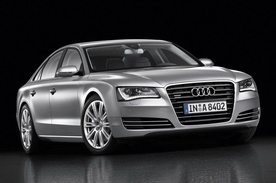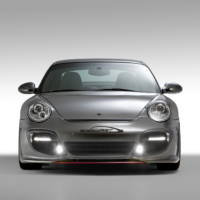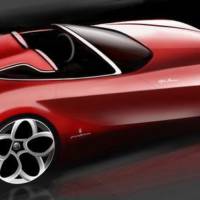The German car maker announced it will exhibit the 2011 Audi A8 hybrid and the Audi e-tron as world premieres at this week’s Geneva Motor Show.
The 2011 Audi A8 hybrid will be powered by a 2.0-litre TFSI engine plus an electric motor, that will produce a total of 245 HP (180 kW) and 480 Nm of torque. Estimated fuel consumption figures indicate the 2011 Audi A8 hybrid will return 37.94 mpg (6.2-litres per 100 Km) while emitting 144 grams of CO2 per Km.
The 2011 Audi A8 hybrid price was not announced but customers will be able to submit their orders in late 2011.
The Audi A1 e-tron promises a driving range of 50 Km (31 miles) when running in electric only mode and has a power output of 102 HP (75 kW). The company says the vehicle’s battery pack is recharged with the help of a single-rotor Wankel engine and an electrical generator. The Audi A1 e-tron is estimated to able to run for 100 Km on just 1.9 litres of fuel (123.8 mpg) while CO2 emissions are as low as 45 g/Km.
Audi press release :
Audi is working intensively to answer questions of
future mobility. In late 2010/early 2011 the Q5 hybrid will reach the
market, the first Audi with a combination of gasoline engine and
electric motor. In Geneva Audi is exhibiting the A8 hybrid for the
first time as a concept car: Its CO2 emissions of 144 g/km (231.75
g/mile) are the best figure in the full-size category. Another world
premiere in Geneva is the A1 e-tron design study, which shows that
Audi’s expertise in electric drive systems extends down into the
compact car segment. At the end of 2012 Audi will launch the e-tron
electric car that was seen last year at the Frankfurt Motor Show (IAA).
A small series will be built, and will be the first electric car to
reach the market.
In the words of Rupert Stadler, Chairman of
the Board of Management of AUDI AG: “In future our customers will be
able to choose from an increasingly broad range of driveline
technologies. To accompany our high-efficiency TDI and FSI engines, we
shall offer electric power in the best possible forms for a wide range
of mobility needs. The hybrid driveline will be followed by
all-electric vehicles.” The “e-tron” name will have an important part
to play. “Just as “quattro” has become a synonym for all-wheel drive,
so “e-tron” is to be the Audi brand name for electric mobility,”
continues Stadler.
When developing alternative drivelines, Audi
is pursuing a strategy of introducing each technology where it is
appropriate for specific model lines and markets, in other words where
it will offer customers significant benefits.
“We regard the
full hybrid as we know it today primarily as a very specific technology
for reducing fuel consumption. In due course plug-in hybrids will
demonstrate their strong points when drivers expect to cover longer
distances in the pure electric mode, in combination with a conventional
engine,” says Michael Dick, Member of the Board of Management for
Technical Development at AUDI AG.
According to Dick: “The
strength of the electric car clearly lies in the urban mobility area,
where the demand for emission-free local transportation will strongly
increase.” In addition to hybrids and electric cars, Audi continues to
develop its long-term competence in the development of basic propulsion
concepts using fuel cells and hydrogen as an energy carrier.
Every
year Audi invests around two billion euros in development projects,
with the focus on continued progress in internal combustion engine
design and associated areas. Electric mobility is a further priority:
In this area the e-tron show car seen at the IAA was a dramatic signal.
At the same time, the various activities are being grouped together
strategically. Audi has established the e-performance project house to
deal with electric mobility topics. Since the autumn of 2009 a team has
been at work on the research project of the same name, with support
from the Federal German Ministry for Education and Research. Members of
the team, consisting of AUDI AG development staff and scientists from
various universities, are working on the development of a new overall
electric vehicle concept, including the body, battery and power
electronics.
Audi A1 e-tron
Audi will be
expanding its “e-tron” model family step by step: the A1 e-tron design
study that the company is exhibiting at the Geneva Motor Show is an
innovative Mega City Vehicle (MCV). Like the sports cars in the same
family, it is electrically propelled and has a range of more than 50
kilometers (31 miles) in city traffic. With a peak power output of 75
kW (102 hp), the A1 e-tron is also fun to drive.
When the
battery’s energy supply is exhausted, it is recharged by an
exceptionally compact “range extender” consisting of a single-rotor
Wankel engine and an electrical generator with a charge rating of up to
15 kW.
This device gives the A1 e-tron an additional range of
200 kilometers (124 miles). According to the draft standard for
determining the fuel consumption of range-extender vehicles, the mean
fuel consumption is 1.9 liters per 100 kilometers (123.8 US mpg),
equivalent to CO2 emissions of only 45 g/km (72.42 g/mile).
Audi A8 hybrid
Audi
is displaying the A8 hybrid as an engineering study at the Geneva Motor
Show. Its two power units – the 2.0 TFSI engine and the electric motor
– have a combined output of 180 kW (245 hp) and a torque of 480 Nm
(354.03 lb-ft). They give the car the same outstanding performance as a
large-capacity conventional six-cylinder engine. This systematic
downsizing demonstrates its fuel-consumption advantages in combination
with the electric driveline: the average fuel consumption is only
6.2 l/100 km (37.94 US mpg), equivalent to CO2 emissions of 144 g/km
(231.75 g/mile).
The Audi A8 hybrid uses the parallel hybrid
configuration – a highly efficient principle that avoids unnecessary
friction and power losses. The powerful electric motor integrated
between the 155 kW (211 hp) four-cylinder petrol engine and the
eight-speed tiptronic transmission can supply a further 33 kW (45 hp)
to the driveline, as well as a vigorous 211 Nm (155.63 lb-ft) of torque.
The
A8 design study is a full hybrid, that is to say the gasoline engine or
the electric motor can propel it either separately or together. In the
pure electric drive mode the car can reach 65 km/h (40.39 mph) and
cover a distance of more than two kilometers (1.2 miles).

01 Mar 2010
0


